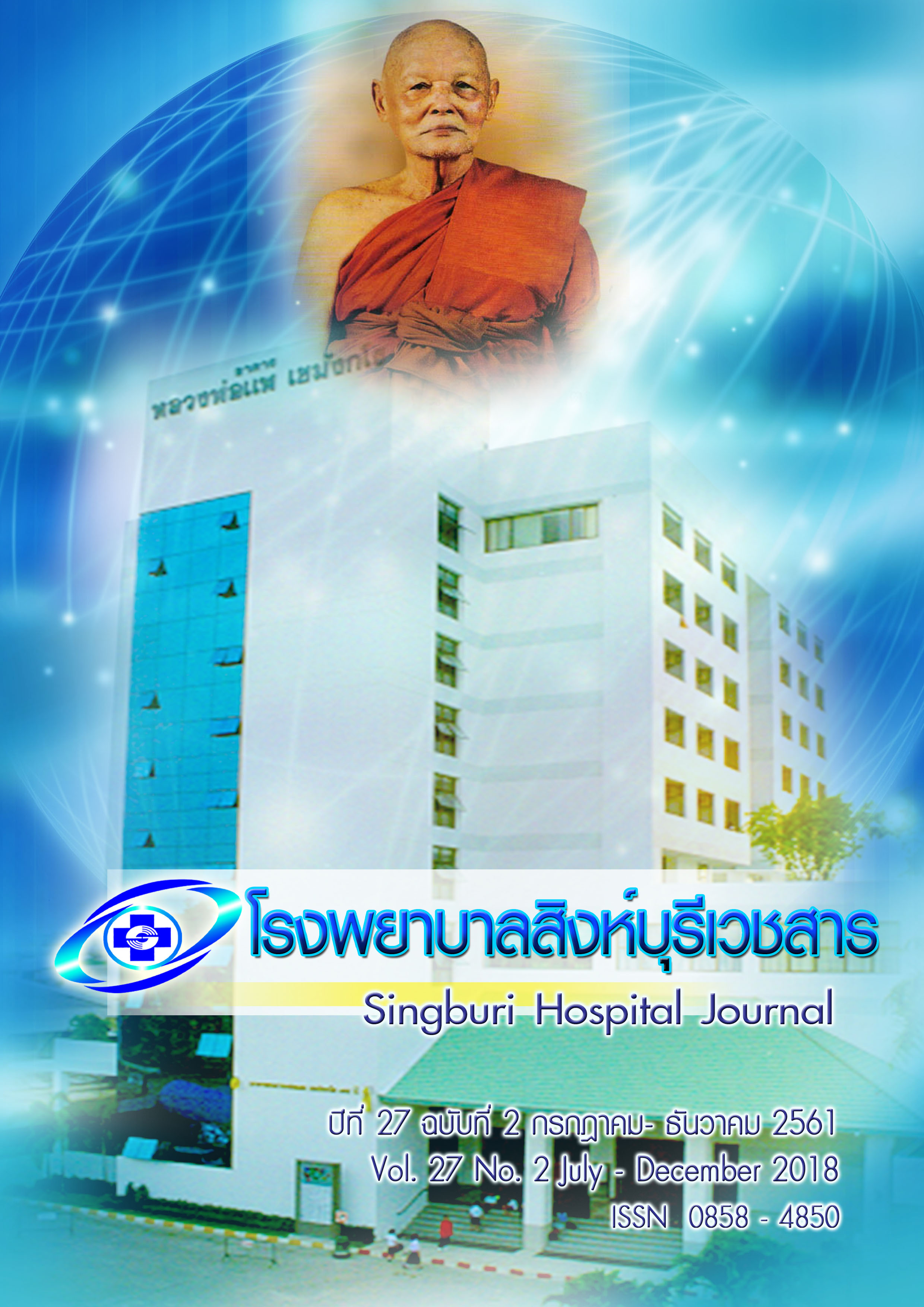The visual ability into vermiform appendix by using 16 slices multidetector computed tomography scanner
Keywords:
Vermiform appendix, Multidetector computed tomography scanner, AdultAbstract
Objective: This research studies the visual ability into vermiform appendix by using 16 slices multidetector computed tomography scanner and comparing the different of visual ability into vermiform appendix, vermiform appendix diameter and ages. In addition, efficiency of 16 slices multidetector computed tomography scanner was also evaluated.
Method: This research is retrospective descriptive study of 119 Patients that they were evaluated with multidetector computed tomography scanner. Before evaluation, patients were not symptoms defining the diagnosis of acute appendicitis. Only one of radiologist read computed tomography. Radiologist does not know the appendectomy history of patients. The data analysis was using descriptive statistics, Chi-square test, independent sample t-test, sensitivity and specificity for evaluation the efficiency of visual ability into vermiform appendix.
Results: The patients with multidetector computed tomography scanning were almost of 101 female patients (84.87%), age > 35 years of 75 patients (63.03%), age average of 54.93 years, 105 patients with visual ability into vermiform appendix. Appendix position was almost found at paracolic (47 patients, 44.76%) midline (37 patients, 35.24%) and retrocecal/retrocolic (21 patients, 20%), respectively. Contrast media were found in appendix of 50 patients (47.61%). The visual ability into vermiform appendix was significant difference in ages (χ2=9.504), p ≤ 0.01. The vermiform appendix diameter was significant difference in gender and ages p <0.05 and 0.02 respectively. The analysis of sensitivity, specificity, accuracy, positive predictive value and negative predictive from multidetector computed tomography scanner were of 100%, 77.80%, 96.04%, 96.19% and 100% respectively.
Conclusion and discussion: From the efficiency evaluation, 16 slices multidetector computed tomography scanner is an instrument that high accuracy for visual ability into vermiform appendix. This instrument help diagnose appendicitis resulting in reducing of appendicitis diagnosis and surgical errors. In addition, the using multidetector computed tomography scanner is an important role for help to plan treatment and surgical wound opening technique.
References
Primatesta P, Goldacre MJ. Appendicectomy for acute appendicitis and for other conditions: an epidemiological study. Int J Epidemiol. 1994;23:155-160.
Cooperman M. Complications of appendectomy. Sur Cli North Am.1983;63:1233-4.
Birnbaum BA, Wilson SR. Appendicitis at the millennium. Radiology. 2000;215:337-48.
van Breda Vriesman AC, Kole Bj, Puylaert JB. Effect of ultrasonography and optional computed tomography on the outcome of appendectomy. Eur Radiol. 2003;13:2278-82.
Tamburrini S, Brunetti A, Brown M, et al. CT appearance of the normal appendix in adults. Eur Radiol. 2005;15:2096-103.
Ege G, Akman H, Sahin A, et al. Diagnostic value of unenhanced CT in adults patients with suspected acute appendicitis. The British journal of radiology. 2002;75:721-5.
Kessler N, Cyteval C, Gallix B, et al. Appendicitis: Evaluation of sensitivity, specificity, and predictive values of US, Doppler US, and laboratory findings. Radiology. 2004;230:472-8.
Thomas A. Foley, Frank E, Mark AN, et al. Differentiation of Nonperforated from Perforated Appendicitis. Accuracy of CT Diagnosis and Relationship of CT Findings to Length of Hospital Stay. Radiology. 2005;235:89-96.
Wise SW, Labuski MR, Kasales CJ, et al. Comparative assessment of CT and sonographic techniques for appendiceal imaging. AJR. 2001.
Benjaminov O, Atri M, Hamilton R, et al. Frequency of visualization and thickness of normal appendix at nonenhanced helical CT. Radiology. 2002;225:400-106.
Scatarige JC, DiSantis DJ, Allen HA III, et al. CT demonstration of the appendix in asymptomatic adults. Gastrointest Radiol. 1989;14(3):271-3.
Grosskreutz S, Goff WB 2nd , Balsara Z, et al. CT of the normal appendix. J Comput Assist Tomogr. 1991;15:575-7.
Jan YT, Yang F-S, Huang JK. Visualization rate and pattern of normal appendix on multidetector computed tomography by using multiplanar reformation display. J Comput Assist Tomogr. 2005;29(4):446-51.
Rao PM, Rhea JT, Novelline RA. Sensitivity and specificity of the individual CT signs of appendicitis: experience with 200 helical appendiceal CT examinations. J Comput Assist Tomogr. 1997;21:686-92.
Jacob JE, Birnbaum BA, Macari M, et al. Acute appendicitis: comparison of helical CT diagnosis focused technique with oral contrast material versus nonfocused technique with oral and intravenous contrast material. Radiology. 2001;220:683-290.
Malone AJ Jr, Wolf CR, Malmed AS, et al. Diagnosis of acute appendicitis: value of unenhanced CT. Am J Roentgenol. 1993;160(4);763-6.
Inneke W, Els P, Michel DM, John dM. The Normal appendix on CT: Does Size Matter? PLOS ONE. 2014;9(5):1-7.
Wakeley CP. The position of the vermiform appendix as ascertained by an analysis of 10,000 cases. J Anat. 1993;67:277-3.
Lane MJ, Liu DM, Huynh MD, et al. Suspected acute appendicitis: nonenhanced helical CT in 300 consecutive patients. Radiology .1999;213:341-6.
Rao PM, Rhea JT, Novelline RA, et al. Helical CT technique for the diagnosis of appendicitis: prospective evaluation of a focused appendix CT examination. Radiology. 1197;202:139-44.
Stefania T, Arturo B, Michele B, Claude BS, Giovanna C. CT appearance of the normal appendix in adults. Eur Radiol. 2005;15:2096-13.
Downloads
Published
How to Cite
Issue
Section
License
Copyright (c) 2022 Singburi Hospital Journal

This work is licensed under a Creative Commons Attribution-NonCommercial-NoDerivatives 4.0 International License.
บทความที่ได้รับการตีพิมพ์เป็นลิขสิทธิ์ของโรงพยาบาลสิงห์บุรี
ข้อความที่ปรากฏในบทความแต่ละเรื่องในวารสารวิชาการเล่มนี้เป็นความคิดเห็นส่วนตัวของผู้เขียนแต่ละท่านไม่เกี่ยวข้องกับโรงพยาบาลสิงห์บุรี และบุคคลากรท่านอื่นๆในโรงพยาบาลฯ แต่อย่างใด ความรับผิดชอบองค์ประกอบทั้งหมดของบทความแต่ละเรื่องเป็นของผู้เขียนแต่ละท่าน หากมีความผิดพลาดใดๆ ผู้เขียนแต่ละท่านจะรับผิดชอบบทความของตนเองแต่ผู้เดียว






